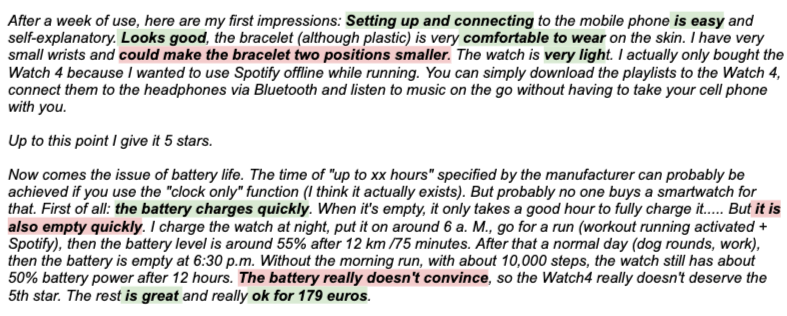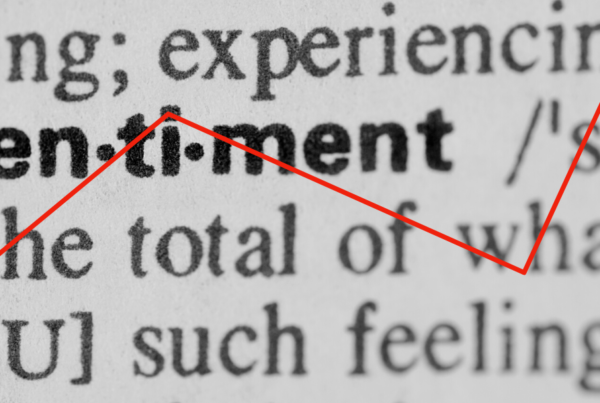In this article, Wonderflow’s Business Intelligence analysts explain two unique and important KPIs: Sentiment Index and Things Gone Wrong (TGW). Without these metrics, our clients and users would not be able to truly understand their customers. Even for non-users, having a general understanding of the impact of the Sentiment Index and TWG may enable you to recognize the potential of Wonderflow’s powerful reviews analytics.
Customer reviews are an incredible source of information for any company, as they provide a significant amount of information both on a quantitative and qualitative level. Thanks to the Star Rating, a company knows how much customers rate their products, and thanks to their Reviews, they can understand what customers like and dislike about their products.
At Wonderflow, as experts in Ratings and Reviews analysis, we have developed some metrics to help companies gain more insights on the performance of their products based on customer reviews: the Sentiment Index and the Things Gone Wrong (TGW). But while Star Rating is a well-known and understood metric, some things still need to be clarified about what these metrics mean and how to use them.
Therefore, this article sheds some light on their definition and uses and sets some benchmarks on what should be considered a “good performance” across different industries.
What are Wonderflow’s Sentiment Index and Things Gone Wrong (TGW)?
The first thing to consider about reviews to understand these KPIs is that each review can talk about multiple positive and negative aspects. Let’s look, for example, at this review about a smartwatch:

Example of a real customer review collected by Wonderflow and sourced from Amazon
The Sentiment Index provides a ratio between the amount of positive and negative comments. It goes from -1 to 1, and it plots the difference between the total positive and negative comments normalized in the interval [-1,+1]. The Sentiment Index gives a reference to understand if a product or brand receives overall more positive or negative comments across all the reviews and topics. The higher the value, i.e., the closer to 1, the better.
The Sentiment Index, together with the TGW, is a more qualitative metric to measure the health of your product or brand beyond just quantitative KPIs such as the Number of Reviews and Average Rating. It is a metric independent of the customers’ evaluation, and it’s based instead on what they say, providing actionable insights on what to improve in case you want to increase the performance of a product/ brand.
The TGW, on the other hand, doesn’t consider the positive mentions like Sentiment Index, but it looks only at how many negative mentions there are out of the existing reviews. It is the average number of complaints across all reviews. The TGW answers the question: How much are my customers complaining on average? The higher the number, the worse.
The main difference between the two metrics is that the Sentiment Index considers both the positive and negative comments and provides a reference to understand if people are expressing overall more positive or negative comments. Still, it doesn’t tell, on average, the number of topics they talk about. For example, suppose the Sentiment Index is 0. In that case, customers express as many positive as negative comments. Still, it would be important to understand if they mention only one positive and one negative aspect or instead 3 aspects for each sentiment. That’s what the TGW does, specifically for the negative sentiment; it tells, on average, the number or amount of topics that customers complain about.
When can I consider my product a high performer within its category?
As we just mentioned, for the Sentiment Index, the higher the value, the better, while for the TGW, the opposite is true, as we want the average amount of complaints to be as low as possible. However, a recurring question from our customers is, “what is a good value of SI and TGW? What is the category average?”. This is, of course, a very relevant question, and thanks to the millions of reviews we analyze every day, we can provide a frame of reference for different categories and countries.
If we look, for example, at Consumer Electronics, the average value for Sentiment Index is 0.6, and for Things Gone Wrong is 0.5; however, if we want to compare ourselves with the best-performing products, then the average value for Sentiment Index goes up to 0.85, and for Things Gone Wrong drops to 0.2. Additionally, we must consider differences by country in case our reference is a specific market.
Poland, for example, is a country where consumers always tend to leave very positive reviews, with an average Star Rating for this category of 4.81, and in fact, the average Sentiment Index is a very high 0.83, and TGW is 0.22; in the United States on the contrary, people tend to be less generous in their reviews, with an average Star Rating of 4.07, while the Sentiment index is 0.65 and the TGW 0.44. These are important differences to consider since a Sentiment Index of 0.75 would probably be a good result compared to the category benchmark and specifically in the US, but not if you are marketing your products in Poland.
Differences across categories are also significant and have to be considered. In Cosmetics, for example, reviews tend to be more positive than in Consumer Electronics: the average Sentiment Index is 0.7, and the average TGW is 0.4. For Tyres, on the other hand, a completely different industry, the differences are even more evident. The average Sentiment Index is a very high 0.83 (up to 0.9 for products with high ratings), and the TGW is 0.16 (down to 0.1 for high-rated products). Also, in this industry, differences across countries are significant, with Japan having a SI of 0.72 and a TGW of 0.44, while Germany has 0.89 and 0.01, respectively.


Tires – Sentiment Index and Things Gone Wrong Breakdown by Country
Final Thoughts
Sentiment Index and Things Gone Wrong are two valuable metrics to monitor beside the more popular Star Rating. The main difference versus this last metric is that they are not a score provided by the consumers directly, but they are derived from what they say; they are therefore very relevant in order to understand if consumers talk about a product in a more positive or negative way, i.e., what is the sentiment of the review. Like the Star Rating, the SI and TGW of a product or a brand can be compared to other products and brands and can be monitored over time. And like for Star Rating, it is always useful to benchmark the performance of a product or brand versus the category of reference and its market to avoid bias.
Building a full picture of your product and brand performance through these metrics is a powerful way to really understand what your strengths and weaknesses are and to develop an actionable plan to grow further.




